Heading out the door? Read this article on the new Outside+ app available now on iOS devices for members! Download the app.
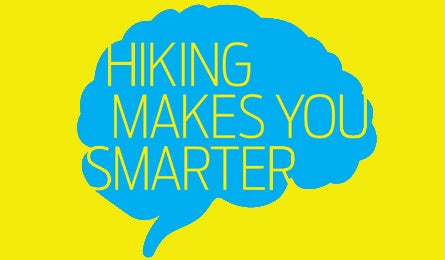
Illustration by Noma Bar
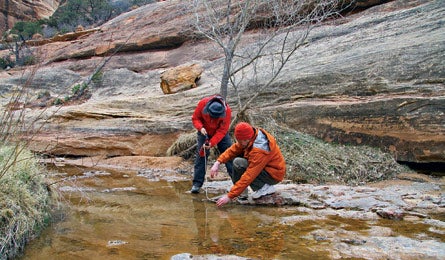
Putting the theory to the test. (Photo by: Elisabeth Kwak-Hefferan)
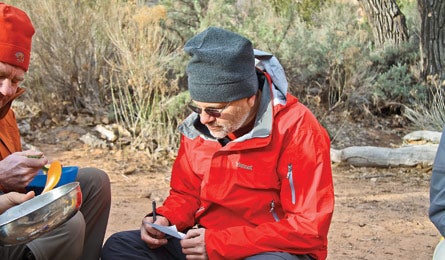
David Strayer (Photo by: Elisabeth Kwak-Hefferan)
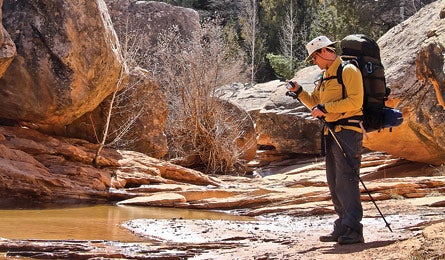
Paul Atchley (Photo by: Elisabeth Kwak-Hefferan)
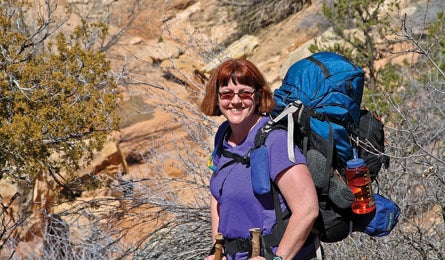
Ruth Ann Atchley (Photo by: Elisabeth Kwak-Hefferan)
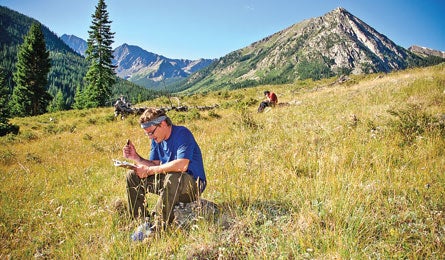
Clear thinking (Photo by: Kim Phillips)
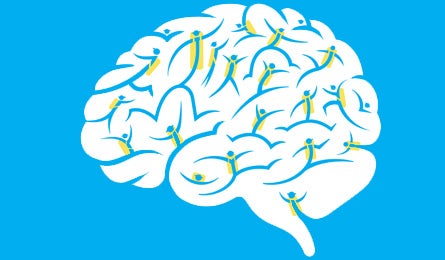
Illustration by Noma Bar
For a neuroscience lab, it sure is cold. Maybe 20℉ or so, judging by the sting on my exposed cheeks. Indeed, an observer would be hard-pressed to see any traditional research going on here. There’s not a single white coat, MRI, or PET scanner to be found. I don’t have a sensor stuck to my scalp. Instead, I’m snuggled in a sleeping bag, surrounded by sagebrush and willow deep within a red-rock maze of hulking sandstone cliffs. But science will be done. It’s my fourth morning in the wild, and I’m supposed to take a cognitive test that’s part of a groundbreaking research project. And I will, as soon as my fingers thaw enough to grip a pen.
The sunrise colors the Ancient Puebloan ruin to the east, and I hunker down in my bag, waiting for the rays to reach my tent. When they do, I unzip the door so I can see the warming sky and unfold the test. Behind me, assorted rustlings and yawns tell me that my five campmates are doing the same thing. The six of us represent the very first step in a cognitive pilot study aimed at exploring a question every reader of this magazine will find intriguing: Does backpacking make you smarter?
The researchers who designed this experiment hypothesize that exposure to nature causes significant, measurable changes to the brain. These changes let you think more clearly, focus more acutely, and perform to your maximum cognitive ability. In short: Wilderness makes you smarter. And the longer you’re out there (up to a point), the smarter you’ll get. Recent studies have already linked wilderness exposure with stress reduction and overall happiness. I can’t help but ponder the ramifications of all this as I consider the first question on my Remote Associates Test. This canyon in southern Utah may not look like an academic setting, but the neuroscientists behind this study could prove that trail time actually makes the brain perform better. Compelling evidence would make hiking a lock for the good-for-you activity hall of fame, to be sure, but that’s not all. Imagine a world in which backpacking becomes the science-recommended way to prepare for the SATs, chess tournaments, and all of life’s biggest mental challenges.
Our science experiment started five days earlier in a dusty motel parking lot in Hanksville, Utah. There, I met the driving force behind the research, David Strayer, Ph.D. A bespectacled, bearded man with a friendly, intellectual air, Strayer is something of a rock star in the world of brain science. His pioneering, 15-year work on the dangers of distracted driving helped spawn public awareness campaigns, dozens of state texting-while-driving bans, a segment on The Oprah Winfrey Show, and a Pulitzer Prize-winning series in The New York Times.
But unlike your average cognitive neuroscientist, Strayer, 54, is just as comfortable in the wilderness as he is in the lab. The University of Utah professor grew up hiking and backpacking near his hometown of Spokane, and he added river rafting to his repertoire about 20 years ago. In high school, Strayer and a few friends cycled 1,000 miles from eastern Washington to the Olympic peninsula—and back—so that they could camp on the beach. Despite the demands of academic life, not to mention marriage and raising two teenage sons, he still spends a total of two months a year canyoneering, rafting, and hiking.
Tomorrow morning, Strayer will lead a small group into the Grand Gulch Primitive Area, an orange-hued playground of sandstone walls dotted with Ancient Puebloan ruins. His purpose is twofold. One, he’s using the trip as a four-day, 30-mile-long brainstorming session to cook up a research design. How can he best test his idea about nature being good for the brain? Strayer is in preliminary talks with Outward Bound about setting up a pilot study with dozens of the program’s students, and details need arranging. To that end, he’s recruited professors Paul Atchley (a cognitive scientist at the University of Kansas) and his wife Ruth Ann (a cognitive/clinical psychologist, also at Kansas). The two are old friends of Strayer’s, as well as colleagues who have a hunch that he just might be right. The three come armed with two different pen-and-paper tests and big ideas about analyzing blood proteins, hormones, respiration, heart rate, and brain activity. I’ve signed on as test subject, along with Utah graduate student Nate Medeiros-Ward and Strayer’s neighbor Richard Boyer.
The second purpose for this trip? Strayer needs his wilderness fix. “I do like to mix business and pleasure,” he says, grinning.
Strayer and the Atchleys are on the frontier of what’s called environmental neuroscience, a field that resides under the umbrella of environmental psychology. But while the latter rather broadly examines the relationships between people and their physical worlds, environmental neuroscience hones in on how one’s surroundings specifically affect the way the brain works. The idea is that something about being in the wilderness causes physiological changes: the release of certain hormones, maybe, or the switch of activity from one brain region to another. Previous studies have linked short-term nature exposure to increased performance on a battery of cognitive tests, but no one knows what happens after a multiday wilderness immersion, or exactly what’s going on in the body and brain.
For Strayer and the Atchleys, the fact that an effect exists is obvious. “You start off with observing—that’s the way science works,” Strayer says. If you’re a backpacker, you’ve probably noticed the same changes Strayer has after a few days on the trail. Stress melts away. You’re better able to focus your thoughts. Your mind just feels clearer, rejuvenated. Paul Atchley, 44, agrees. “The fact that you get the same sorts of stories—the reports of restoration—from everyone you talk to indicates that there must be something there.”
The next morning, we gather at Blondie’s, a roadside diner, to load up on pancakes and start phase one. We’re all going to take a classic cognitive test before we get out on the trail. The exam will establish a baseline—how our brains are working now, before our dose of Vitamin Nature. If this measure—called the Remote Associates Test—is easy enough to implement for our little group, the scientists might include it in the larger Outward Bound study.
“Science is starting!” announces Ruth Ann Atchley, 42, over coffee. She passes us each a sheet of paper with 10 sets of three words on it. Our task is deceptively simple: Figure out a fourth word that fits with each of the others. For example, if the set reads FLOOR, PLAY, FAIR, the answer is GROUND. (Get it? “Ground floor,” “playground,” “fairground.”) The Remote Associates Test measures your brain’s ability to make fresh connections between ideas. And though the test seems word game-y, its results correlate strongly with other measures of creativity, problem-solving, and higher-level thinking.
I get a few answers quickly, then hit a brick wall. INCH, DEAL, PEG…what the hell? It doesn’t help that as I’m staring blankly at the page, my breakfast companions seem to be briskly wrapping up their tests. Need a lesson in humility? Try doing a brainteaser with a bunch of neuroscientists.
But if their hypothesis holds true, I’ll be getting smarter with every step into the wilderness. And I get a rematch: We’re due to take the test again on the fourth morning of the trip. Maybe I’ll redeem myself. But there’s no time to dwell on it now. We have seven winding miles of the Grand Gulch ahead of us today, and I have yet another cognitive test to take before we start.
At the trailhead, the March weather is overcast but warm; the sun even breaks through enough for me to take off my puffy as I settle onto a picnic table with grad student Medeiros-Ward for an Operation Span test (O-Span), another contender for the Outward Bound study. This one measures the ability to maintain focus in the face of distraction, a key part of what’s called executive function. Executive function is a catchall category for components of higher-order thinking—tasks like planning ahead, making decisions, problem solving, organizing, and paying attention.
The gist of the O-Span: Remember a series of up to seven spoken words in order. But there’s a catch. You have to solve a simple math problem after hearing each word. Because the brain processes math and language separately, the test makes you constantly switch your focus from one region to another—basically, forced multitasking. I gaze out over the sagebrush flats and try to concentrate.
Medeiros-Ward’s scientifically detached delivery goes like this: “Does three divided by one minus one equal three? Hat. Does two times two minus one equal one? Flag.” Numbers. Word. Numbers. Word. It’s frustrating. As soon as I think I’ve cemented a word in my mental list, a math problem smashes it out of mind. I end up scoring a 68 out of 75 on the math and only a 42 out of 75 on word recall. “Looks like you’re not a super multitasker,” Medeiros-Ward tells me cheerfully.
Evening, day one. We’re camped on the sandy banks of a dry creek near the mouth of Toadie Canyon. From the trailhead, our crew descended through the kinks of Kane Gulch to join the gently curving main stem of Grand Gulch. We poked around a few ruins as we hiked deeper into the sandstone maze, snapping photos and peering into thousand-year-old kivas. Even after just 10 hours or so in the wilderness, my thoughts have noticeably simplified: It’s chilly. I’m hungry. Where can we find water?
Strayer and the Atchleys think this “caught up in the moment” effect is a big part of why nature is so refreshing for the brain. In modern professional life, few of us enjoy the luxury of focusing on only what’s in front of us. Unfortunately, that sort of divided thinking doesn’t do the brain any favors. Why? A refresher in high school bio might be in order: The brain is divided into different regions, each of which takes the lead in a different set of tasks. Some regions handle the basics (breathing, heartbeat), others oversee more complicated functions (like emotions), and the frontal lobe (aka prefrontal cortex) is the Ph.D. of the whole operation. This region, located in the front quarter of the brain, is ground zero for advanced thinking.
We draw heavily on the frontal lobe when we concentrate hard—preparing a complex presentation, say, or driving on a busy freeway. But the buzzers, sirens, and ringtones of life also give this region a workout. Whenever you switch your attention from one task to another, you tax the frontal lobe. That happens involuntarily when an attention-grabbing signal intrudes on your consciousness—flashing lights, ringing cell phones, blaring horns—but increasingly, we do this to our brains on purpose. Guilty or not: Does your typical day involve juggling multiple projects, constant email surveillance, regular peeks at Facebook, and maintaining several text conversations at once? You’re not alone if it does. But while multitasking may be a badge of honor in the 21st century, Strayer says it’s going to cost you in terms of cognitive performance.
“Just like a muscle can get tired with overuse, the brain can get tired, too,” Strayer tells me as the sun tracks west over our camp. And when that happens, research shows, people suffer from a general, short-term cognitive decline: They perform worse on creativity measures, complete tasks more slowly, and are more likely to make errors.
The sun dips below the horizon as we’re finishing up a burrito dinner, taking the day’s warmth with it. We hastily wash dishes, then retreat to our down cocoons. Am I going about life all wrong? I wonder as I zip up my bag. Is all that multitasking I think I need to do in order to be successful actually making me…stupider?
Neuroscientists don’t claim to be the first to have noticed the nature cure. Heavyweight thinkers the likes of Henry David Thoreau, John Muir, and Aldo Leopold noted a certain improvement of the mind after a wilderness jaunt. Muir urged us to head for the mountains, where “the winds will blow their own freshness into you.”
But recently, scientific evidence has begun to catch up to literary insights. Some tests have targeted the aforementioned happiness factor. A series of 2010 University of Rochester studies found exposure to nature through 15-minute walks, viewing photos, and even just imagining nature led to increased “vitality,” which they explain as “feeling more alive” and energized. Others have looked specifically at brain function. In a 2008 University of Michigan study, subjects who took a 50-minute walk through a nearby arboretum boosted their scores on one cognitive test by 20 percent (not so for subjects who took a stroll down a busy urban street). But until now, the work has been primarily lab-based (showing images) or short-term (like the arboretum walk). So what does disappearing into the woods for a few days do for you?
Nobody’s really checked—which is what has Strayer and the Atchleys so excited about their potential collaboration with Outward Bound. It would give them access to organized groups of backpackers. The team could finally peek into what three or four days of 24-hour exposure to the great outdoors does to a person’s brain. “One of the strengths of the proposed study is that unlike most of the other work that’s been done, this would actually be with real people on the ground in a wild environment,” Paul Atchley says.
Dreams of scientific breakthroughs take a backseat to more elemental concerns on our second morning in Grand Gulch: We need water, and soon. We pack up and hike over to the fresh spring Paul Atchley scouted last night, where Ruth Ann volunteers to filter water. While she pumps, the team explores nearby, wandering into side canyons and looking for petroglyphs. I lean against my pack by the spring’s edge, idly watching as ravens flap by and cottonwood leaves flutter.
It doesn’t look like we’re doing much—but this might be the secret to getting smarter. The hypothesis, summed up by what’s known as Attention Restoration Theory (ART), goes like this: There are two main types of thinking, top-down and bottom-up. Top-down thinking, aka directed attention, is what you’re doing most days when you ask your brain to write up a report or read a memo. Frontal lobe stuff. Bottom-up thinking, or “soft fascination,” is what happens when distractions dissolve and you can just go with the flow. Think of a typical morning in camp: Maybe you wake up and head to a nearby stream to fetch water. On the way there, you might think: Wow, that sunbeam looks cool streaming through the aspen. I wonder if it’ll be hot today? Oh look, a deer print. I can still see my breath. Each thought comes and goes freely, without anything shrieking for your attention. You don’t expend any mental effort or concentration, but instead attend to anything that naturally captures your interest. Critically, this type of thinking happens in regions other than the frontal lobe. And that, the theory goes, lets the beat-up frontal lobe relax and recharge, refilling your reservoir of focus—thus restoring your cognition to full power.
This away-from-it-all feeling—and the benefits it imparts—is tough to produce anywhere but the outdoors. (One exception: Studies show meditation also does a bang-up job at restoring cognitive function.) Even a week’s vacation to the beach will still involve man-made distractions like traffic, TV, and the lure of checking email just one more time. That kind of living may be reality nowadays, but it’s not how the brain evolved to work. Humans have spent the vast majority of our evolutionary history in surroundings very much like the one I’m in with Strayer right now, and our brains are wired to thrive here. “Our modern environment is something that we’ve invented in the last 100 years or so,” Strayer says. “Frankly, we don’t know what that’s going to do to us.”
The next morning, I wake up early and sneak out of my tent, camera in hand. We’re camped on a natural platform, 50 feet above the sandy wash below. I leave the trail and scramble up a rusty sandstone fin. I pick my way up, trusting the stickiness of my rubber soles and thinking of not much except the view. By the time I’ve reached the top and trained my zoom lens back on camp, the scientists are up and puttering around. “We’re in the peak part of soft fascination,” Strayer tells me later as we pump spring water just up the trail. “I’d really have to stop and think to tell you what day of the week it is right now.”
It’s Friday, three days into the trip—the magic number, according to both hiker anecdotes and preliminary research. Strayer calls it the “three-day syndrome,” or the optimized cognitive state you reach after spending at least that much time in the backcountry. Lab studies prove that even 30 minutes of nature make a difference in cognitive test scores; Strayer’s hunch is that those benefits accumulate. And that makes backpackers uniquely positioned to reap the rewards. “That doesn’t mean that others can’t benefit, but really big improvements are associated with disconnecting for longer periods of time.”
So does that mean that spending, say, three weeks hiking the John Muir Trail will buy me a superhuman prefrontal cortex? Not quite, Strayer tells me: “You probably have the full dose now. I can take three days or five days or 10 days, but in terms of restorative properties, I’m probably already there.” Notice that “probably”—nobody has measured this hypothesis scientifically yet. But if you’re choosing between a two-week backpacking trip once a year and a bunch of three-day weekends closer to home, neuroscientists bet that shorter and more frequent trips give you the biggest cognitive bang for your buck.
Other researchers suspect that even smaller doses of nature can add up. Marc Berman, a post-doctoral fellow at Toronto’s Rotman Research Institute and coauthor of the Michigan arboretum study, says, “Three days is an intensive kind of restoration. But imagine people going for half-hour walks, three days a week, for a year. That could have a cumulative effect.” Still, if research finds that longer periods cause measurably bigger benefits, he says, “Maybe people need to put resources into being able to do that.”
How much wilderness you need for a “full dose” of brain restoration (and how long that dose lasts) is only one of the topics Strayer and the Atchleys excitedly discuss this morning. They bat ideas about the research design back and forth, debating the best tool for capturing the nature effect. The crew is starting with the foundation: They must demonstrate that time in the wilderness actually does something before they can start explaining that something.
“My dream is not to do these pen-and-paper kinds of tests,” Strayer says. “I think the best thing would be if we could just do blood draws and look at blood proteins that are created by interaction with nature. It’s remarkable how fast these proteins are altered by your experience—you get changes within an hour, maybe faster.” Blood proteins provide a peek into how the body is using certain neurotransmitters, including those related to frontal lobe function. Theoretically, blood protein counts could signal altered levels of the neurotransmitters essential to higher-level thinking.
Translation: This nature stuff isn’t all in your head. There could be real, physical changes that unfold the moment you step onto the trail. In addition to blood proteins, saliva samples provide insight into the body’s hormone levels and stress response, while a portable EEG could help researchers infer how taxed the frontal lobe is at a given time. Berman and a team of researchers from the University of Michigan and the Rotman Research Institute are in the midst of a study comparing fMRI scans from people looking at pictures of nature versus urban environments. (An fMRI—functional MRI, which measures brain function, as opposed to an MRI, which looks at anatomy—examines changes in brain activity in different regions.) The team is also planning more work to compare hormone levels before and after the nature walk.
On our fourth morning, in a camp near Jailhouse Ruin, I put my brain to the test once again. Bundled in my bag, I unfold my second Remote Associates Test. ATHLETES, WEB, RABBIT. The answer comes to me in just a moment: FOOT. And maybe it’s only because I expect to do better this time, or because it’s quieter here than it was in Blondie’s diner, but the entire task seems easier. Answers surface in my mind almost automatically, without the frustration of the first go-round.
I’m not the only one who feels smarter. When Ruth Ann Atchley analyzes each of our before and after Remote Associates Tests, the group tallies an average improvement of 45 percent. Imagine that sort of improvement applied to other aspects of everyday life. What would happen to your bank account if your work performance took a 45-percent jump?
After our Utah trip, the Strayer-Atchley research team settles on a pilot group of 57 adult Outward Bound participants. Some will be backpacking in Colorado, some mountaineering in the North Cascades, others exploring Alaska, Maine, or Utah.
Strayer and the Atchleys have decided to start with a pen-and-paper test after all. Before-and-after blood protein analyses at $500 a pop are simply too expensive at this point—without a grant—to conduct. Besides, these paper tests essentially measure the same effect, albeit less precisely. And if the scientists can demonstrate a robust effect with a classic paper test, then perhaps they can build enough steam to start in on the more ambitious measures. They choose the Remote Associates Test, deeming the O-Span too complicated, and too boring. (But it did capture an effect in me: I gained 13 points on my post-trip verbal score, a 31-percent jump.)
Half of the Outward Bound groups will take the Remote Associates Test on the first day of the course; the other half will take it on the fourth morning of their trip (having each group take the test only once corrects for the dreaded “practice effect,” when participants do better simply because they know what to expect and have more time to hone their test-taking skills). If the day four subjects score significantly higher than the day one group, then the research team will be the first to demonstrate that extended wilderness time correlates to measurable cognitive improvements. And that would be a big deal.
August 2011: One pilot group made up of eight grimy participants in Outward Bound’s weeklong backpacking course prepares to make its contribution to the research. The subjects scatter across an alpine meadow 11,000 feet high in Colorado’s Collegiate Peaks Wilderness, perching on rocks or sitting cross-legged on sleeping pads. Each one bends over a paper test, tapping a pencil or gazing into the cloudless sky in concentration. It’s their fourth morning in the wilderness.
One by one, the subjects wrap up their tests and trot over to the instructor. He collects each sheet of paper and tucks it into a manila envelope, ready to be scored, entered into a spreadsheet, and statistically analyzed. The participants don’t know exactly what this study is all about, but everyone agrees that this wilderness immersion relaxes the brain.
Like most teenagers and twentysomethings, these eight students are used to constant technological distraction at home—one participant, 20-year-old Jeremiah Espinosa, tells me ruefully that he can still feel the cell phone he doesn’t have vibrating in his pocket like a phantom limb. “At home, I don’t go five minutes without doing anything,” says recent college grad Elena Vespoli. “I always have something, and my brain is jumping from task to task and from piece of technology to piece of technology. Out here, you can focus.”
The Outward Bound results come in one morning in early October. Paul Atchley’s voice is buoyant when I call him for details. Day one test-takers earned a mean score of 4.14 out of 10; day four subjects, 6.08. That might not sound like a big difference, but in scientific terms, it’s a powerful change. When the data are corrected for variables (like the age of subjects, which can affect results), the experiment shows a whopping 50-percent increase in creative thought. “I’m thrilled—I cannot believe how well this turned out,” Ruth Ann Atchley says.
The crew is abuzz about where to go from here. They’ll submit the study to scientific journals, naturally. And a more intensive follow-up with Outward Bound or another wilderness group is planned. (Want to take part yourself? See “Are You Smarter?,” left.) There’s talk of applying for research grants, then maybe getting those blood protein tests off the ground. “Big claims require big evidence,” Paul Atchley cautions. They have to eliminate other explanations for the effect. Could the vigorous exercise of outdoor activity have anything to do with it? (Other studies have demonstrated great mental benefits from aerobic activity.) Maybe simply unplugging from distracting electronics is behind the effect? Environmental neuroscience is really in its infancy—there’s a lot more work to be done.
The analytical part of my brain understands this. But a deeper part of me doesn’t need to wait for empirical data to know that nature does have a profound effect on the way we feel and think. Wilderness does clear my head. I do feel refreshed and on-point after a long weekend in the woods. That’s one of the reasons I keep going back. This cutting-edge research is in some ways just a bonus for those of us already drawn to the wilderness. What we love to do turns out to be very, very good for us.
But consider the implications of concrete evidence. What could we do with the “discovery” that nature is an effective, cheap, and zero-side-effect highway to higher intellectual function? Maybe this will translate into daily outdoor time for kids in school. Backpacking Fridays at the office so you can regularly squeeze in those three days on the trail. And who could argue against wilderness protection when we need wild places to help our brains reach full potential? At the very least, it would be a fantastic excuse to get out this weekend.
That’s how I think of it. Though Strayer and the Atchleys warn me about the preliminary nature of this stuff every time we speak, I’m a believer. Over the months I’ve spent reporting this story, I’ve taken a hard look at my own daily habits and realized I’m steeped in the distraction-heavy lifestyle. So now I consciously avoid doing 10 things at once. I try to check email at regularly planned breaks, and sometimes I turn my cell phone off for two or three days at a time. On those occasions I wouldn’t get reception anyway, because I’m out in the wild, backpacking more than I ever have. While my weekend outings are just as much fun as they’ve always been, I think of these trips differently. They’ve become a vital investment in my own brainpower, a much-needed splash of smart sauce on an overtired frontal lobe.
Does it work? Am I really thinking more clearly, solving problems more effectively? I can point to my before and after tests from Utah as evidence, or I can submit a blood sample for analysis, but I don’t really need to. Hell yes, I’m smarter. I can feel it. Can’t you?
